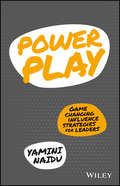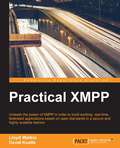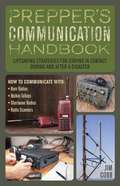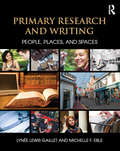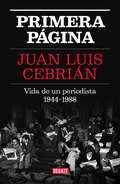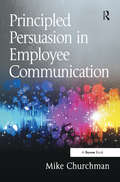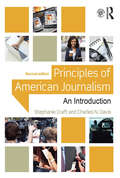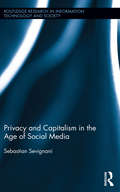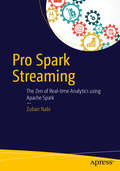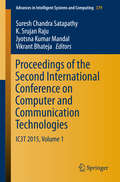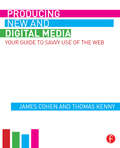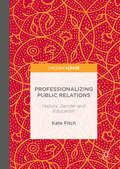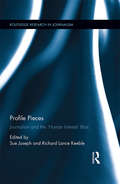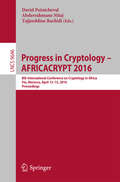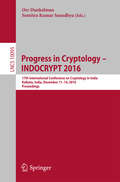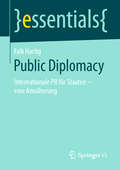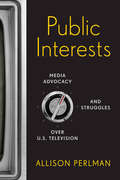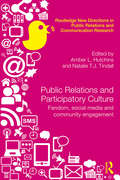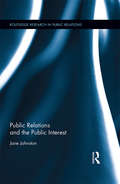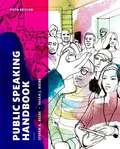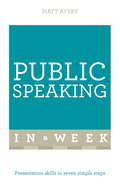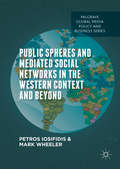- Table View
- List View
Power Play
by Yamini NaiduDiscover the secrets of influence, impact and transformational leadership Power Play is the powerful and practical 21st century guide to mega-impact and influence, providing business leaders with explosive influence strategies to move people into action and results. Influence, like gravity, pulls success into your orbit and gives you the power to make real changes in your relationships, your organisation and the world. This book explores the different types of power and you will learn when to coerce, when to collaborate and when to connect. You'll delve into areas of influence that you may not have considered, including the power of message, context, empathy, humour, positioning, love and more. This book identifies the strengths and weaknesses of each of these influence tools and offers practical tips so you can create a seismic shift in your influence while maintaining authenticity and integrity. Influence is the key factor that allows you to build powerful relationships that facilitate more effective leadership. It can mean the difference between achieving results and falling short, keeping clients or losing them, winning that pitch or blowing it. This book shows you how to amplify your influence and turbo charge your impact in every area. Understand the different types of power Discover new tools of influence and the art of power play Explore influence strategies with impact and integrity Become a power player and deliver results Influence is a science, and it's the key to your personal and professional success. Power Play helps you build a bottomless supply, and wield it with authenticity, compassion and integrity.
Practical XMPP
by Lloyd Watkin David KoelleUnleash the power of XMPP in order to build exciting, real-time, federated applications based on open standards in a secure and highly scalable fashion About This Book * Learn about the fundamentals of XMPP and be able to work with the core functionality both server-side and in the browser * Build a simple 1-to-1 chat (the "Hello World" of XMPP), explore multi-user chat, publish subscribe systems, and work with a decentralized social network * Author Lloyd Watkins is a member of the XMPP standards committee Who This Book Is For If you want to learn about the fundamentals of XMPP, be able to work with the core functionality both server-side and in the browser then this book is for you.No knowledge of XMPP is required, or of TCP/IP networking. It's important that you already know how to build applications of some form, and are looking get a better understanding of how to implement XMPP for one or more of its many uses. You should be interested in the decentralized web, know HTML, and likely know JavaScript and NodeJS. You will probably know JSON, and hopefully XML (this is the native output of XMPP). What You Will Learn * Install and configure an XMPP server and use it to connect from a traditional desktop client and send a message * Build a simple server-side application that will respond to messages from our logged in desktop client * Install and run XMPP-FTW, connect to the server from the browser, and handle incoming/outgoing messages * Connect to a multi-user chat room, send/receive stanzas, add a room password, join a protected room, set the room's subject, and change a user's affiliation * Get to grips with the publish-subscribe extension of XMPP and use it to build a pusher system that can make any website real-time * Build a simple XMPP component and create an extension for XMPP-FTW that allows you to use your own custom format * Build an XMPP version of the classic game "Pong" In Detail XMPP (eXtensible Messaging and Presence Protocol) is a messaging protocol that enables communication between two or more devices via the Internet. With this book, developers will learn about the fundamentals of XMPP, be able to work with the core functionality both server-side and in the browser, as well as starting to explore several of the protocol extensions. You will not only have a solid grasp of XMPP and how it works, but will also be able to use the protocol to build real-world applications that utilize the power of XMPP. By the end of this book, you will know more about networking applications in general, and have a good understanding of how to extend XMPP, as well as using it in sample applications. Style and approach Through a number of hands-on projects, this book shows you how to build usable applications that highlights a feature of XMPP.
Prepper's Communication Handbook: Lifesaving Strategies for Staying in Contact During and After a Disaster (Preppers)
by Jim CobbThe ultimate guide to acquiring, assembling and utilizing life-saving emergency communication systems.When disaster strikes, your calls, texts and emails may not work. After 9/11, Hurricane Katrina and Hurricane Sandy, cell phones were rendered useless when transmission towers were destroyed, and networks became overloaded. Having an alternative way to reach family and loved ones at these critical moments is essential. With Prepper's Communication Handbook, you learn the best tips, tricks and expert secrets for surviving when phones and the Internet fail.Exploring the best options for every disaster scenario, this hands-on guide features in-depth coverage on a wide variety of lifesaving emergency communication systems, including:* Satellite Radio* Shortwave* NOAA Receiver* GMRS and FRS Radios* Citizen’s Band* Ham Radio* Radio Scanners* MURS RadioIf you’re looking for a “take you by the hand” approach to learning how to set up a ham rig, look elsewhere. The focus here is on providing an overview of all the different communication tools out there, allowing you to decide for yourself which ones are best suited for your needs, situation, and experience level.After discussing the various communication tools available, the focus turns to improving communication skills, such as conflict resolution and interpreting body language. Without these skills, tools are all but useless. With Prepper’s Communication Handbook, you will find all the basic skills you need to prepare to stay connected when the grid goes down.
Primary Research and Writing: People, Places, and Spaces
by Lynee Lewis Gaillet Michelle F. EbleDeveloped for emerging academic writers, Primary Research and Writing offers a fresh take on the nature of doing research in the writing classroom. Encouraging students to write about topics for which they have a passion or personal connection, this text emphasizes the importance of primary research in developing writing skills and abilities. Authors Lynée Lewis Gaillet and Michelle F. Eble have built a pedagogical approach that makes archival and primary research interesting, urgent, and relevant to emerging writers. Students are able to explore ways of analyzing their findings and presenting their results to their intended readers. With in-text features to aid students in understanding primary research and its role in their writing, chapters include special elements such as: Communities in Context – Profiles of traditional and digital communities that help students understand the characteristics of communities and group members Profiles of Primary Researchers – Spotlights on professionals, giving an illuminating look into the role primary research plays in real-world research and writing Student Writing – Examples of exemplary student writing that demonstrate how research can be relevant, engaging, and interesting, with annotations. Invention Exercises - Exercises designed to help students locate primary investigation within communities that they already understand or find appealing Writing Exercises - Writing exercises that offer students practice in exploring communities and investigating primary materials. Readings – Annotated readings with questions to guide analysis, pulled from a variety of rich sources, that give students inspiration for undertaking their own research projects. This text has a robust companion website that provides resources for instructors and students, with sample syllabi, chapter overviews, lecture outlines, sample assignments, and a list of class resources. Primary Research and Writing is an engaging textbook developed for students in the beginning stages of their academic writing careers, and prepares its readers for a lifetime of research and writing.
Primera página: Vida de un periodista 1944-1988
by Juan Luis CebriánPrimera página son las memorias de Juan Luis Cebrián, primer director de El País, pero también el apasionante relato de los convulsos años que llevaron a España de una sangrienta y rancia dictadura a la democracia, contado por un testigo imprescindible. Nacido en Madrid en 1944, en una familia de periodistas, Juan Luis Cebrían pronto empezó a pisar las principales redacciones de la prensa de la época, primero la de Pueblo, luego la de Informaciones, donde fue subdirector con apenas 20 años, y también la de Cuadernos para el diálogo, cuyo espíritu fue un ensayo de la convivencia que haría posible la transición. Tras un fugaz paso por la dirección de informativos de RTVE, fue el primer director de El País, que pronto se convirtió en el periódico de referencia de España y símbolo de la reconquista de las libertades y la aspiración a una sociedad moderna y europea. Fueron años muy intensos que Cebrián vivió en primera línea, con secuestros de empresarios, atentados contra las redacciones, tensión en las calles, guerras soterradas por el control de un medio de comunicación que se hacía cada vez más poderoso, y hasta un golpe de Estado que amenazó con descarrilar el tren de la democracia. «Naturalmente, los hechos aquí relatados son todos ciertos, lo que no quiere decir que la versión de los mismos sea la única posible. He descrito mis relaciones con el poder, mis visiones profesionales, mis convicciones intelectuales. No pretendo que este sea un documento histórico, tampoco un ditirambo autocomplaciente ni emprender una saga de pequeñas venganzas contra nadie. Tampoco voy ahora a establecer verdades absolutas en las que no creo. Trato solo de explicar mis sentimientos, mis reacciones, mis apegos y desapegos en las vicisitudes varias en las que la vida me ha puesto.»Juan Luis Cebrián Primera página, que se lee con la tensión de una novela de aventuras, es un testimonio imprescindible de un periodo crucial de la historia reciente de España.
Principled Persuasion in Employee Communication
by Mike ChurchmanPrincipled Persuasion in Employee Communication highlights a new but significant dilemma for organisational leaders. Will they continue on the same track that, since the nineteenth century, has led them to exert increasing control over their employees? Or will they take another path, one that leads towards a new type of working environment where the culture encourages freedom of communication and movement? This book argues for an approach to employee communication that sets out to liberate employees from the stifling constraints that organisations continue to impose on them. Principled Persuasion is so-called because it uses persuasive techniques, based on clear principles, to create new, forward-looking organisational cultures. It sets out to increase employee happiness and minimise the harms done to employees at work. It grounds itself on a strong ethical base composed of fundamental, universal principles. It introduces a new approach to the use of language, not only calling for more clarity and meaning in organisational communication, but also for a more conscious use of rhetorical techniques to change vocabulary, metaphors and internal dialogue for the better. Make no mistake, most organisations have totally underrated the strategic importance of employee communication. Principled Persuaders understand that the key to dealing with the unpredictable events about to unfold in the twenty-first century will be a new way of communicating with the workforce. The flexibility, adaptability and innovation that will be needed to survive and prosper in coming decades can only be achieved by liberating employees, not imprisoning them further in established systems and processes.
Principles Of Digital Communication: A Top-Down Approach
by Bixio RimoldiThis comprehensive and accessible text teaches the fundamentals of digital communication via a top-down-reversed approach, specifically formulated for a one-semester course. The unique approach focuses on the transmission problem and develops knowledge of receivers before transmitters. In doing so it cuts straight to the heart of the digital communication problem, enabling students to learn quickly, intuitively, and with minimal background knowledge. Beginning with the decision problem faced by a decoder and going on to cover receiver designs for different channels, hardware constraints, design trade-offs, convolutional coding, Viterbi decoding, and passband communication, detail is given on system-level design as well as practical applications in engineering. All of this is supported by numerous worked examples, homework problems, and MATLAB simulation exercises to aid self-study, providing a solid basis for students to specialize in the field of digital communication and making it suitable for both traditional and flipped classroom teaching.
Principles of American Journalism: An Introduction
by Stephanie Craft Charles N. DavisDesigned to engage, inspire and challenge students while laying out the fundamentals of the craft, Principles of American Journalism introduces readers to the core values of journalism and its singular role in a democracy. From the First Amendment to Facebook, the new and revised edition of this popular textbook provides a comprehensive exploration of the guiding principles of journalism and what makes it unique: the profession's ethical and legal foundations; its historical and modern precepts; the economic landscape of journalism; the relationships among journalism and other social institutions; the key issues and challenges that contemporary journalists face. Case studies, exercises, and an interactive companion website encourage critical thinking about journalism and its role in society, making students more mindful practitioners of journalism and more informed media consumers.
Privacy and Capitalism in the Age of Social Media (Routledge Research in Information Technology and Society #18)
by Sebastian SevignaniThis book explores commodification processes of personal data and provides a critical framing of the ongoing debate of privacy in the Internet age, using the example of social media and referring to interviews with users. It advocates and expands upon two main theses: First, people’s privacy is structurally invaded in contemporary informational capitalism. Second, the best response to this problem is not accomplished by invoking the privacy framework as it stands, because it is itself part of the problematic nexus that it struggles against. Informational capitalism poses weighty problems for making the Internet a truly social medium, and aspiring to sustainable privacy simultaneously means to struggle against alienation and exploitation. In the last instance, this means opposing the capitalist form of association – online and offline.
Pro Spark Streaming
by Zubair NabiLearn the right cutting-edge skills and knowledge to leverage Spark Streaming to implement a wide array of real-time, streaming applications. This book walks you through end-to-end real-time application development using real-world applications, data, and code. Taking an application-first approach, each chapter introduces use cases from a specific industry and uses publicly available datasets from that domain to unravel the intricacies of production-grade design and implementation. The domains covered in the book include social media, the sharing economy, finance, online advertising, telecommunication, and IoT. In the last few years, Spark has become synonymous with big data processing. DStreams enhance the underlying Spark processing engine to support streaming analysis with a novel micro-batch processing model. Pro Spark Streaming by Zubair Nabi will enable you to become a specialist of latency sensitive applications by leveraging the key features of DStreams, micro-batch processing, and functional programming. To this end, the book includes ready-to-deploy examples and actual code. Pro Spark Streaming will act as the bible of Spark Streaming. What you'll learn Spark Streaming application development and best practices Low-level details of discretized streams The application and vitality of streaming analytics to a number of industries and domains Optimization of production-grade deployments of Spark Streaming via configuration recipes and instrumentation using Graphite, collectd, and Nagios Ingestion of data from disparate sources including MQTT, Flume, Kafka, Twitter, and a custom HTTP receiver Integration and coupling with HBase, Cassandra, and Redis Design patterns for side-effects and maintaining state across the Spark Streaming micro-batch model Real-time and scalable ETL using data frames, SparkSQL, Hive, and SparkR Streaming machine learning, predictive analytics, and recommendations Meshing batch processing with stream processing via the Lambda architecture Who this book is for The audience includes data scientists, big data experts, BI analysts, and data architects.
Proceedings of the 2015 International Conference on Communications, Signal Processing, and Systems
by Qilian Liang Wei Wang Jiasong Mu Baoju ZhangThis book brings together papers presented at the 4th International Conference on Communications, Signal Processing, and Systems, which provides a venue to disseminate the latest developments and to discuss the interactions and links between these multidisciplinary fields. Spanning topics ranging from Communications, Signal Processing and Systems, this book is aimed at undergraduate and graduate students in Electrical Engineering, Computer Science and Mathematics, researchers and engineers from academia and industry as well as government employees (such as NSF, DOD, DOE, etc).
Proceedings of the Second International Conference on Computer and Communication Technologies
by Suresh Chandra Satapathy Jyotsna Kumar Mandal Vikrant Bhateja K. Srujan RajuThe book is about all aspects of computing, communication, general sciences and educational research covered at the Second International Conference on Computer & Communication Technologies held during 24-26 July 2015 at Hyderabad. It hosted by CMR Technical Campus in association with Division - V (Education & Research) CSI, India. After a rigorous review only quality papers are selected and included in this book. The entire book is divided into three volumes. Three volumes cover a variety of topics which include medical imaging, networks, data mining, intelligent computing, software design, image processing, mobile computing, digital signals and speech processing, video surveillance and processing, web mining, wireless sensor networks, circuit analysis, fuzzy systems, antenna and communication systems, biomedical signal processing and applications, cloud computing, embedded systems applications and cyber security and digital forensic. The readers of these volumes will be highly benefited from the technical contents of the topics.
Producing New and Digital Media: Your Guide to Savvy Use of the Web
by Thomas Kenny James CohenProducing New and Digital Media is your guide to understanding new media, diving deep into topics such as cultural and social impacts of the web, the importance of digital literacy, and creating in an online environment. It features an introductory, hands-on approach to creating user-generated content, coding, cultivating an online brand, and storytelling in new and digital media. This book is accompanied by a companion website--designed to aid students and professors alike--that features chapter-related questions, links to resources, and lecture slides. In showing you how to navigate the world of digital media and also complete digital tasks, this book not only teaches you how to use the web, but understand why you use it. KEY FEATURES For students- a companion site that features research resources and links for further investigation For instructors- a companion site that features lecture slides, a sample syllabus, and an Instructor's Manual. Features a unique approach that covers media studies aspects with production and design tutorials. Covers up-to-date forms of communication on the web such as memes, viral videos, social media, and more pervasive types of online languages.
Professionalizing Public Relations
by Kate FitchThis groundbreaking study offers new insights into public relations history with a focus on the changing relationship between women and public relations, the institutionalization of public relations education, and the significance of globalization in Australia in the second half of the twentieth century. Drawing on archival and interview research, it reveals how the industry's professionalization led to the development of an occupational identity along national and gendered lines. It also challenges common misconceptions around the origins of public relations and women's early contributions and careers. Adopting a critical approach, Professionalizing public relations avoids corporatist perspectives on the historical development of public relations by focusing on the processes of professionalization and their significance for gender and education, and by situating this study in a broader global context. The findings reveal dynamic and contested conceptualizations of public relations knowledge and expertise, and the significance of historical processes for contemporary understandings of the industry.
Profile Pieces: Journalism and the 'Human Interest' Bias (Routledge Research in Journalism)
by Sue Joseph Richard Lance KeebleThis book examines the history, theory and journalistic practice of profile writing. Profiles, and the practice of writing them, are of increasing interest to scholars of journalism because conflicts between the interviewer and the subject exemplify the changing nature of journalism itself. While the subject, often through the medium of their press representative, struggles to retain control of the interview space, the journalist seeks to subvert it. This interesting and multi-layered interaction, however, has rarely been subject to critical scrutiny, partly because profiles have traditionally been regarded as public relations exercises or as ‘soft’ journalism. However, chapters in this volume reveal not only that profiling has, historically, taken many different forms, but that the idea of the interview as a contested space has applications beyond the subject of celebrated individuals. The volume looks at the profile’s historical beginnings, at the contemporary manufacture of celebrity versus the ‘ordinary’, at profiling communities, countries and movements, at profiling the destitute, at sporting personalities and finally at profiling and trauma.
Progress in Cryptology - AFRICACRYPT 2016
by David Pointcheval Abderrahmane Nitaj Tajjeeddine RachidiThis bookconstitutes the thoroughly refereed proceedings of the 8th International Conference on theTheory and Application of Cryptographic Techniques in Africa, AFRICACRYPT 2016,held in Fes, Morooco, in April 2016. The 18papers presented in this book were carefully reviewed and selected from 65submissions. The aim of Africacrypt 2016 is to provide an international forumfor practitioners and researchers from industry, academia and government fromall over the world for a wide ranging discussion of all forms of cryptography. Topicsof interest are such as lattices; elliptic curves; secret-key cryptanalysis;efficient implementations; secure protocols; and public-key cryptography.
Progress in Cryptology – INDOCRYPT 2016
by Orr Dunkelman Somitra Kumar SanadhyaThis book constitutes the refereed proceedings of the 17th International Conference on Cryptology in India, INDOCRYPT 2016, held in Kolkata, India, in December 2016. The 23 revised full papers presented in this book were carefully reviewed and selected from 84 submissions. The focus of the conference includes works on Public-Key Cryptography, Cryptographic Protocols, Side-Channel Attacks, Implementation of Cryptographic Schemes, Functional Encryption, Symmetric-Key Cryptanalysis, Foundations, and New Cryptographic Constructions.
Public Diplomacy: The Rise Of Confucius Institutes (essentials)
by Falk HartigDiese essential führt kompakt in das Konzept der Public Diplomacy ein. Public Diplomacy wird international in Wissenschaft und Praxis umfassend debattiert und praktiziert, in Deutschland findet der Begriff bisher allerdings nur wenig Beachtung. Es erläutert die Hintergründe, skizziert Akteure, Instrumente und Zielgruppen sowie ähnliche Begriffe. Zudem wirft das essential Schlaglichter auf bisherige Forschungslücken und leitet Möglichkeiten für weitere Forschungen ab, die sowohl für Wissenschaft und Praxis relevant sind.
Public Interests: Media Advocacy and Struggles over U.S. Television
by Allison PerlmanNearly as soon as television began to enter American homes in the late 1940s, social activists recognized that it was a powerful tool for shaping the nation's views. By targeting broadcast regulations and laws, both liberal and conservative activist groups have sought to influence what America sees on the small screen. Public Interests describes the impressive battles that these media activists fought and charts how they tried to change the face of American television. Allison Perlman looks behind the scenes to track the strategies employed by several key groups of media reformers, from civil rights organizations like the NAACP to conservative groups like the Parents Television Council. While some of these campaigns were designed to improve the representation of certain marginalized groups in television programming, as Perlman reveals, they all strove for more systemic reforms, from early efforts to create educational channels to more recent attempts to preserve a space for Spanish-language broadcasting. Public Interests fills in a key piece of the history of American social reform movements, revealing pressure groups' deep investments in influencing both television programming and broadcasting policy. Vividly illustrating the resilience, flexibility, and diversity of media activist campaigns from the 1950s onward, the book offers valuable lessons that can be applied to current battles over the airwaves.
Public Relations and Participatory Culture: Fandom, Social Media and Community Engagement (Routledge New Directions in PR & Communication Research)
by Amber Hutchins Natalie T.J. TindallWhile public relations practitioners have long focused on the relationship between organizations and their stakeholders, there has never been a time when that relationship was so dominated by public participation. The new model of multiple messages originating from multiple publics at varying levels of engagement is widely acknowledged, but not widely explored in scholarly texts. The established model of one-way communication and message control no longer exists. Social media and an increasingly participatory culture means that fans are taking a more active role in the production and co-creation of messages, communication, and meaning. These fans have significant power in the relationship dynamic between the message, the communicator, and the larger audience, yet they have not been defined using current theory and discourse. Our existing conceptions fail to identify these active and engaged publics, let alone understand virtual communities who are highly motivated to communicate with organizations and brands. This innovative and original research collection attempts to address this deficit by exploring these interactive, engaged publics, and open up the complexities of establishing and maintaining relationships in fan-created communities.
Public Relations and the Public Interest (Routledge Research in Public Relations)
by Jane JohnstonIn this book, Johnston seeks to put the public interest onto the public relations ‘radar’, arguing the need for its clear articulation into mainstream public relations discourse. This book examines literature from a range of fields and disciplines to develop a clearer understanding of the concept, and then considers this within the theory and practice of public relations. The book’s themes include the role of language and discourse in establishing successful public interest PR and in perpetuating power imbalances; intersections between CSR, governance, law and the public interest; and how activism and social media have invigorated community control of the public interest. Chapters explore the role of the public interest, including cross-cultural and multicultural challenges, community and internal consultation, communication choices and listening to minorities and subaltern publics.
Public Speaking Handbook (Fifth Edition)
by Susan J. Beebe Steven A. BeebeNOTE: You are purchasing a standalone product; MyCommunicationLab does not come packaged with this content. If you would like to purchase both the physical text and MyCommunicationLab, search for ISBN-10: 0134126904 / ISBN-13: 9780134126906. That package includes ISBN-10: 0133753980 / ISBN-13: 9780133753981 and ISBN-10: 0133907279 / ISBN-13: 9780133907278. MyCommunicationLab should only be purchased when required by an instructor. <p><p> For courses in Public Speaking An audience-centered approach to public speaking in a student-friendly reference format Public Speaking Handbook, Fifth Edition emphasizes the importance of analyzing and considering the audience at every point in the speech-making process. Using a student-friendly reference format that facilitates quick and easy access to key information, authors Steven and Susan Beebe present a balance of theory and practice to guide students on how to enhance their public speaking skills. By focusing student attention on the dynamics of diverse audiences, ethics, and communication apprehension, Public Speaking Handbook bridges the gap between the classroom and the real world. Also available with MyCommunicationLab#65533; MyCommunicationLab for the Public Speaking course extends learning online, engaging students and improving results. Media resources with assignments bring concepts to life, and offer students opportunities to practice applying what they've learned. And MediaShare offers an easy, mobile way for students and instructors to interact and engage with speeches, visual aids, group projects, and other files. <p>Please note: this version of MyCommunicationLab does not include an eText. Public Speaking Handbook, Fifth Edition is also available via REVEL(tm), an immersive learning experience designed for the way today's students read, think, and learn.
Public Speaking In A Week: Presentation Skills In Seven Simple Steps
by Matt AverySunday: Write a speech to which people will want to listen that is well-researched, uses stimulating content and is tailored to the needs of the audienceMonday: Learn how to use effective speaking techniques such as projection, commanding the space and interaction with your audienceTuesday: Discover more advanced public speaking techniques such as using audio and visual aids, varying your pace, and adding tone and inflectionWednesday: Ensure you are fully prepared through memorizing key points and rehearsing with othersThursday: Control your nerves with relaxation techniques and confidence tricks of the tradeFriday: Engage with your audience by keeping to your script, making eye contact and varying your delivery Saturday: Understand the common mistakes to avoid so that you won't lose your audience's attention
Public Speaking Student Workbook (2015-2016 Edition)
by PearsonDesigned to provide the readers with the important information on public speaking; equipped with specific course policies and required speeches; hence develop lifetime skills for communication.
Public Spheres and Mediated Social Networks in the Western Context and Beyond
by Mark Wheeler Petros IosifidisSocial media is said to radically change the way in which public communication takes place: information diffuses faster and can reach a large number of people, but what makes the process so novel is that online networks can empower people to compete with traditional broadcasters or public figures. This book critically interrogates the contemporary relevance of social networks as a set of economic, cultural and political enterprises and as a public sphere in which a variety of political and socio-cultural demands can be met. It examines policy, regulatory and socio-cultural issues arising from the transformation of communication to a multi-layered sphere of online and social networks. The central theme of the book is to address the following questions: Are online and social networks an unstoppable democratizing and mobilizing force? Is there a need for policy and intervention to ensure the development of comprehensive and inclusive social networking frameworks? Social media are viewed both as a tool that allows citizens to influence policymaking, and as an object of new policies and regulations, such as data retention, privacy and copyright laws, around which citizens are mobilizing.
